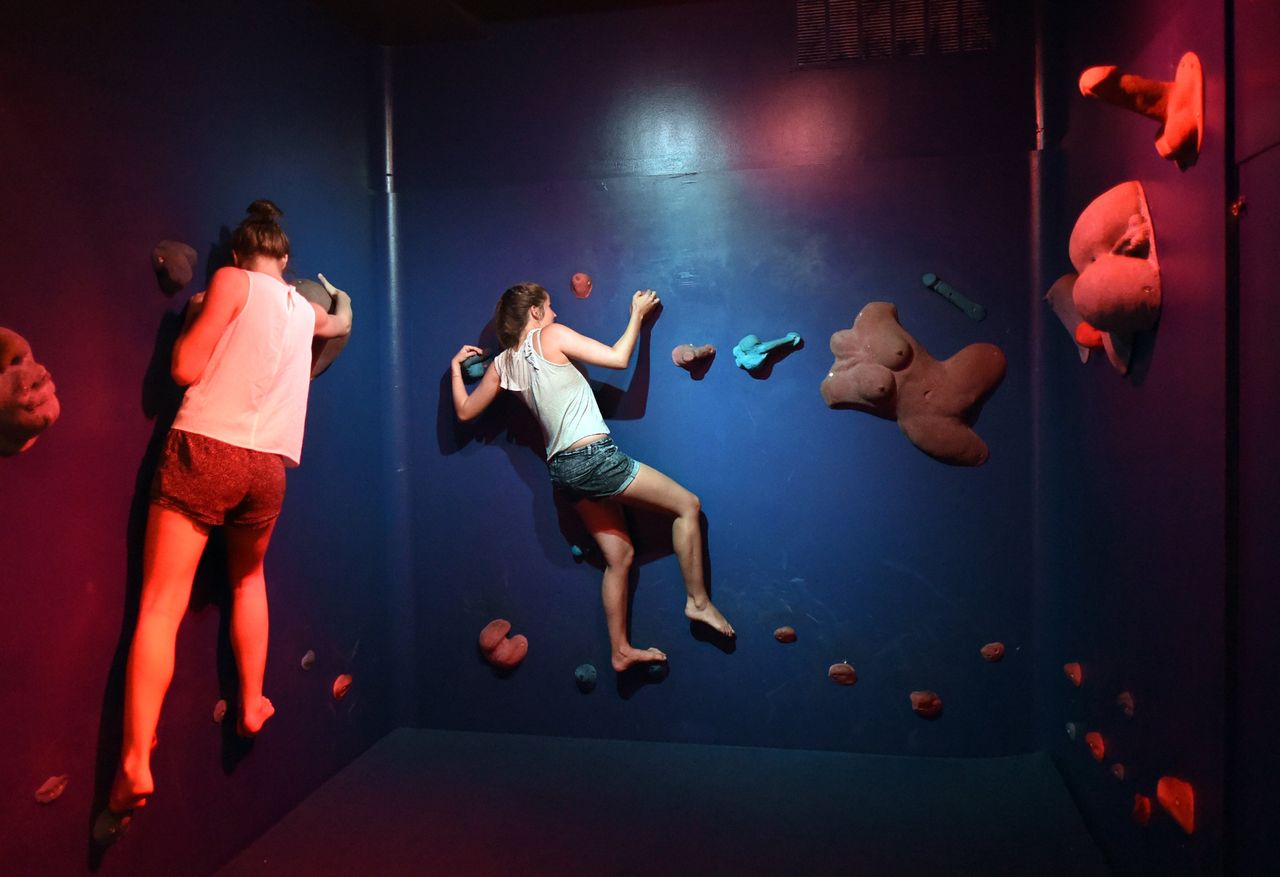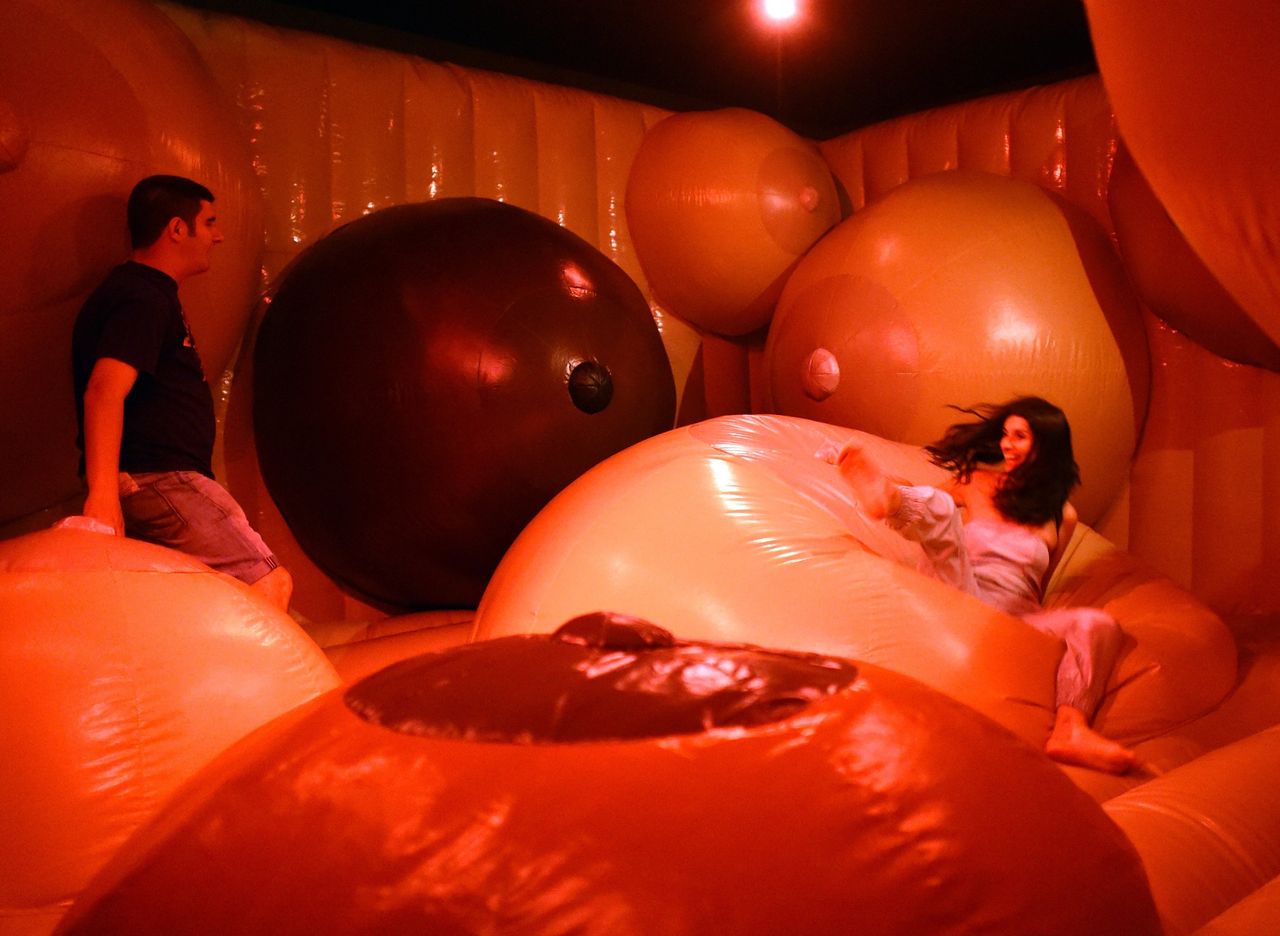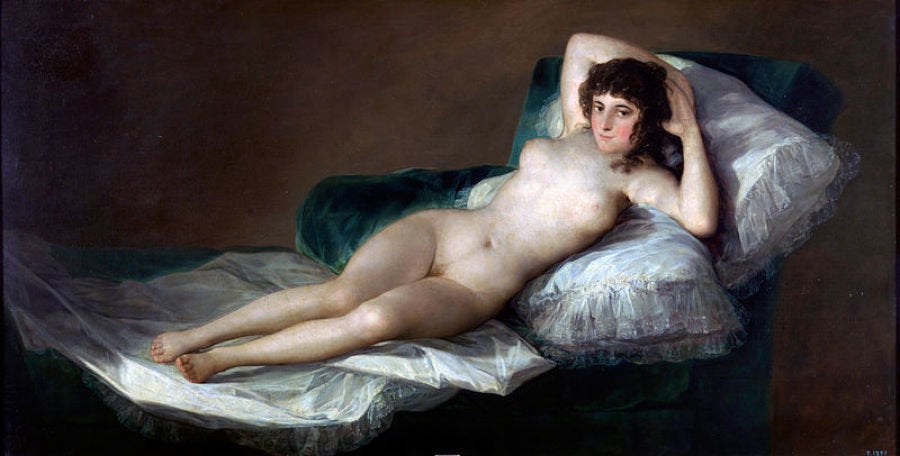Most traditional art museums are teeming with nude images, many of which, in one way or another, illuminate particular moments in the history of sexuality.
There are Greek vase paintings and their myriad sexual positions, the reclining painted nudes immortalized by Titian and Manet, the mythological tales brought to life with no sparing of NSFW detail. And yet, sex remains, for the most part, largely unspoken inside the sacred (and often, yes, uptight) museum space, hovering silently beyond the museum plaques and audio guides.
Unless, of course, you're at the Museum of Sex, New York's whimsical sanctuary of sexuality. Then you may just be jumping upon a bounce house of inflatable breasts or climbing a rock wall of penises.

Since it opened in 2002, the Museum of Sex has explored the history and evolution of human sexuality through immersive exhibitions at once informative and imaginative, vulgar and whimsical, cheeky and rigorous. Just as the sex act itself dissolves those pesky boundaries between bodies, so MoSex excels at doing away with distinctions between seriousness and play, masterpiece and schlock.
Most importantly, sex is not shamed, whispered or cast aside as frivolous or offensive at the museum. Rather, sex is studied, shared and celebrated in all its salacious glory, as a crucial site of knowledge, passion and human culture.
For the past decade, Sarah Forbes has worked as a curator for MoSex, an experience she elaborates on in her upcoming book Sex in the Museum: My Unlikely Career At New York’s Most Provocative Museum. I reached out to Forbes to learn more about her experiences as the most well known sex curator in the game.

Do you remember the first time you heard about, learned of or witnessed sex?
I grew up in a household that never made sex a taboo. Instead of it being a single moment where I was shocked by the idea of it, it was a topic that was introduced to me slowly, in age-appropriate ways, across my childhood. While I would say that by kindergarten I was aware of how babies were made, this is quite different from our, at times, more pornographic definition of what sex is, can be or believed to be.
What was the attitude around sex in your family and community growing up?
While my own household was very open-minded and information-centric, where I could ask any question I had, I remember from an early age realizing this wasn’t the norm. I would see this represent itself in two extremes, either friends who spoke about sex as only a ballet of extreme pornographic acts or as a topic that needed to be spoken of in whispers and code. For me, I grew up with the idea that sex was a normal and healthy part of life. Only as I entered young adulthood did I realized what a gift this had been.
When you first attended the museum, you write that you were struck by the exhibit "Sex Among the Lotus, 2,500 Years of Chinese Erotic Obsession." Can you talk about what in particular moved you?
"Sex Among the Lotus" captivated me in the way in which it blended history and present day content, and was unapologetically frank in its discussion of sex. So many other exhibitions seem to hide this aspect or rely upon innuendo. Merging fine art, anthropological artifacts as well as contemporary commercial representations of sex, this exhibition gave me, then as a patron, a scope of understanding the fascinating continuum of sexuality.
Museums were a big part of my upbringing (my grandfather’s fiber glass company had fabricated the famous blue whale at the American Museum of Natural History), and though I had visitor experiences across a diversity of institutions, the inherent character of the Museum of Sex felt revolutionary to me on this first visit. It wasn’t just because it was about sex, it was the way in which it was dedicated to presenting the topic without the veil of censorship found elsewhere.
“It is about creating experiences that educate and contribute to a larger discourse around sex, sexuality and gender.”
Did you have apprehensions about accepting a position at the museum?
Although my background is in anthropology, I had never intended to work in a museum. In many ways, I had issues with how identity is represented across some institutions, in addition to a disdain for how anthropological artifacts have been acquired historically. If I had any apprehensions it was about working in a museum, and never about the topic of sex, though it is always an eyebrow-raising word on your business card.
What reactions did you receive from your friends, family and significant other at the time?
While the people in my life, before I started working at the Museum, didn’t think of me differently because of my role at the Museum of Sex, those I met afterward certainly did. Some people assumed that my job was a direct line to my personal life and my private desires. Particularly as a young woman, many assumptions were made about me. (Was curator a euphemism for sex worker?)
When people asked how I got the job, there was always an implication that my own sexual prowess had something to do with it, which I’m certain is not an experience most other professionals experience. Dating in NYC as a “curator of sex” certainly led to some memorable experiences.

What did your position as curator of the museum entail?
As the curator of the Museum of Sex, I was responsible for the totality of exhibition creation. This included the whole arc of a project from ideation, research, sourcing of artifacts, writing of exhibition text, coordinating with outside experts and advisors as well as working with designers to establish all aspects of the exhibitions' visual identity. I had a hand in every single aspect and stage of the exhibitions' formation. As a small museum, I learned how to project manage not only the content creation, but also the management of all the physical aspects (construction, fabrications, installation, etc.) that turns an idea into reality.
What were some of the greatest challenges you faced?
The greatest challenge of my work was doing all of this with a very small staff and limited budgets, particularly in those early years of the museum, when people weren’t yet sure what in the world the Museum of Sex was. Yet, in many ways, having to do much ourselves -- of course, a tremendous challenge when you are in it -- I now credit for my skills and strengths as a curator, content creator and project manager.
What was one exhibition or initiative at the museum you're particularly proud of?
The exhibition the "Sex Lives of Animals" will always have a very special place in my heart, as it was a dynamic synthesis of science and fine art, resulting in a powerful presentation. With sculptures by Rune Olsen, design by Pentagram and the research of more than a dozen academic advisors, it was an exhibition that in many ways created a “new natural history” model for museums.
How would you describe the mission of the Museum of Sex?
The mission of the museum has evolved since its inception in 2002, but for me, at its heart, it is about creating experiences that educate and contribute to a larger discourse around sex, sexuality and gender.
“While we still have a long way to go, over the last decade working in this field, I have seen a tremendous cultural normalization when it comes to sex.”
Have you seen the larger conversation surrounding sex and sexuality grow since you began working at MoSex?
When I first started working at the Museum of Sex in 2004, the institution wasn’t allowed to advertise in the subways due to the taboo of the topic. Now the Museum can be found on billboards across the city and spotted on your morning commute.
While, in some ways, this is due to people’s understanding that the Museum of Sex is actually a museum, it is also a part of a larger cultural shift in which the mainstream is more aware of and open to the diversity of sexuality. The Internet has exposed many to the depths of definitions of sex that were once considered fringe. Objects such as vibrators are no longer hidden novelty objects, but rather designer luxury lifestyle pieces. While we still have a long way to go, over the last decade working in this field, I have seen a tremendous cultural normalization when it comes to sex.
What is a common misconception about the museum you'd like to dispel?
While I think this is improving, the juxtaposition of the word “museum” and the word “sex” has been difficult for people. What is it that we expect a Museum of Sex to be? What do we expect to see? In many ways, it all goes back to our personal definitions of how we view sex. But I do think it’s very important to remind people that the inclusion of the word “Museum” was a very purposeful decision.
What are your hopes for the future of the museum?
After almost 12 years I have recently left the Museum to focus on the promotion of my book, Sex in the Museum: My Unlikely Career At New York’s Most Provocative Museum as well as prepare for a move to London this summer. Across the more than 20 exhibitions I have worked on it has been an incredible adventure creating content that is both educational and entertaining, which I really do believe has contributed to a discourse surrounding sex and sexuality, an institutional objective.
I hope the museum continues its effort to be a revolutionary institution, creating one-of-a-kind museum going experiences, and I am personally excited to extend this ethos to projects that take shape within and beyond the museum walls.

